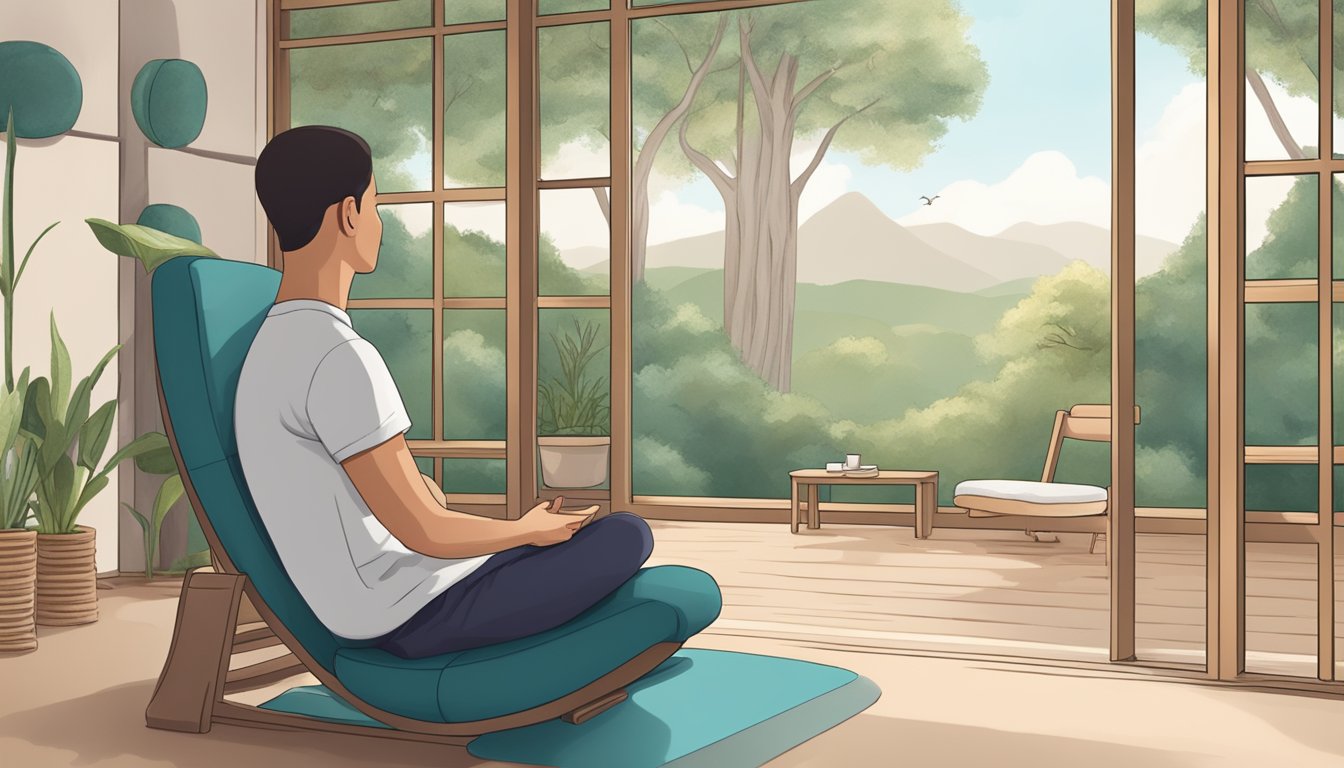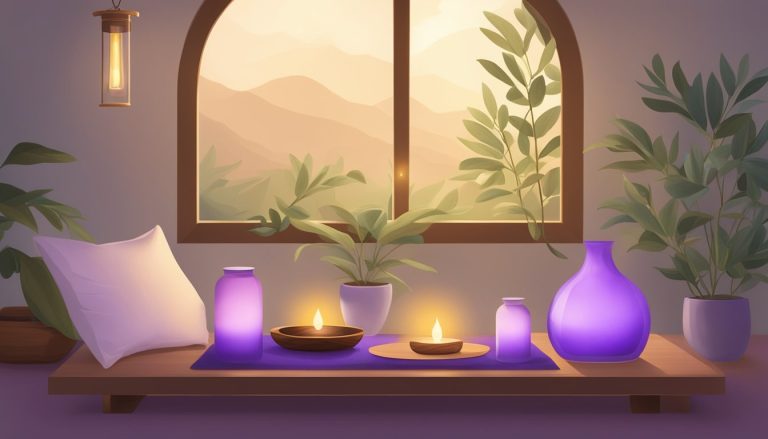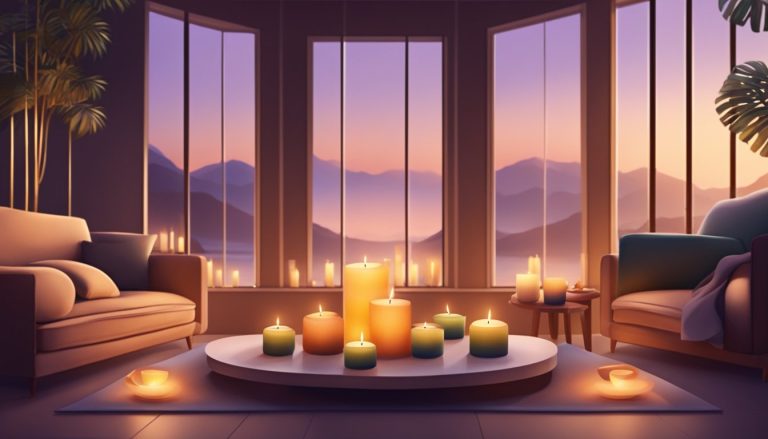Meditation Room Ideas on a Budget: Transforming Spaces Affordably
Creating a meditation space doesn’t have to be a strain on your finances. I’ve found that with some thoughtful planning, it’s entirely possible to design a tranquil area for relaxation and peace without spending a lot.
The key is to start by selecting the right location in your home—whether it’s a small corner in your bedroom or a dedicated room—where you can retreat from the bustle of everyday life.
It’s important to consider how much space you have available and to ensure that this space feels inherently peaceful to you.
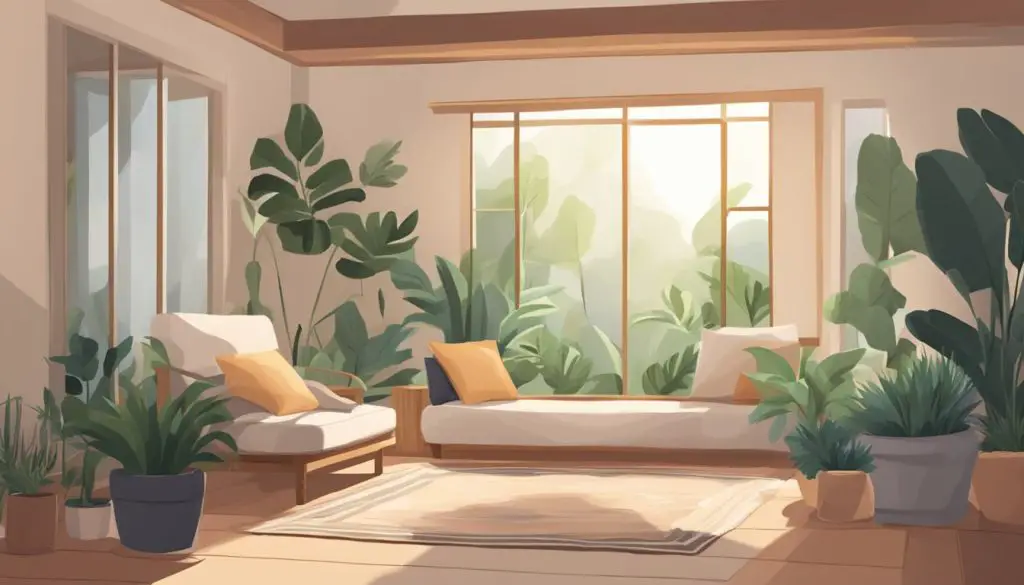
I’ve also learnt that incorporating elements of nature, such as natural light or houseplants, can significantly enhance the peacefulness of the space without requiring a large investment.
When it comes to decor, choosing calming colours and budget-friendly items that resonate with tranquillity rather than cluttering the area can help in creating a serene environment.
Comfort is crucial, so items like a soft rug or a comfortable cushion are vital.
I also suggest creating a focal point for your meditation, such as a candle, statue, or any object that aids in bringing your attention to the present moment.
Key Takeaways
- A meditation space can be created inexpensively through careful selection of location and use of available space.
- Bringing natural elements and tranquil colours into the space contributes to a peaceful atmosphere.
- Comfort and simplicity are essential, focusing on creating a focal point and minimising clutter.
Table of Contents
Step 1: Choosing the Perfect Location
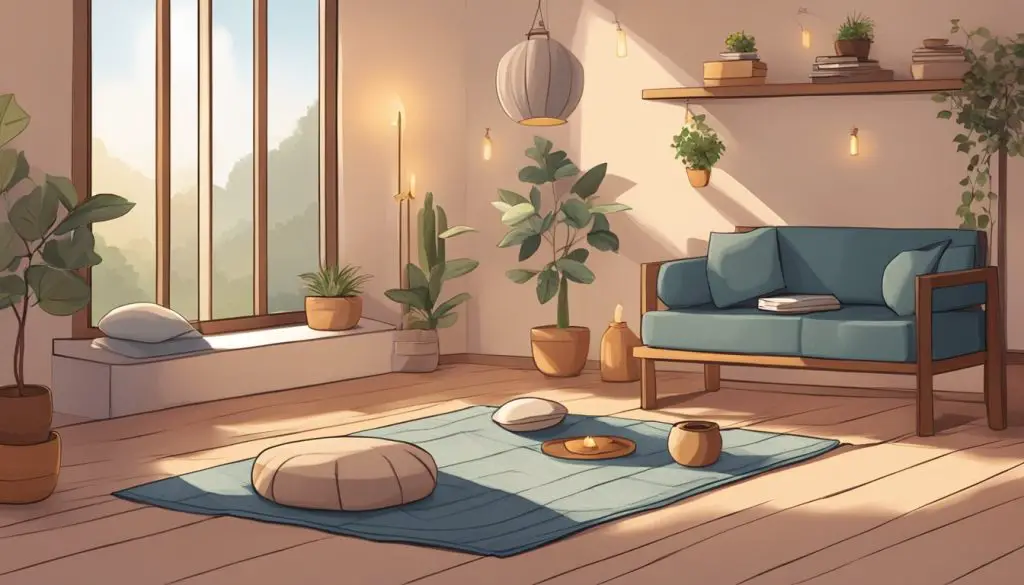
When I’m setting up a meditation space on a budget, my priority is to find a spot that feels secluded and serene. Natural light is a bonus, and if I can use a spare room, that’s ideal.
Privacy and Quiet
For a meditation area, privacy is paramount. I look for a spot where interruptions are minimal. This could be:
- A quiet corner of my bedroom or living room.
- An underutilised closet large enough to sit comfortably in.
Natural Light and Windows
Natural light can elevate the ambience of a meditation space. Here’s what I consider:
- Windows that provide a soft, natural glow without harsh direct sunlight.
- Light-coloured curtains or blinds that can diffuse light gently.
Making Use of a Spare Room or Dedicated Space
If I’m lucky enough to have a spare room, it becomes my dedicated meditation sanctuary. If not, I look for:
- Areas like a spacious landing at the top of the stairs or a section of another room, setting it apart with room dividers or screens.
- Minimal furnishing to maintain a sense of spaciousness within the dedicated space.
Step 2: Incorporating Nature into Your Sanctuary
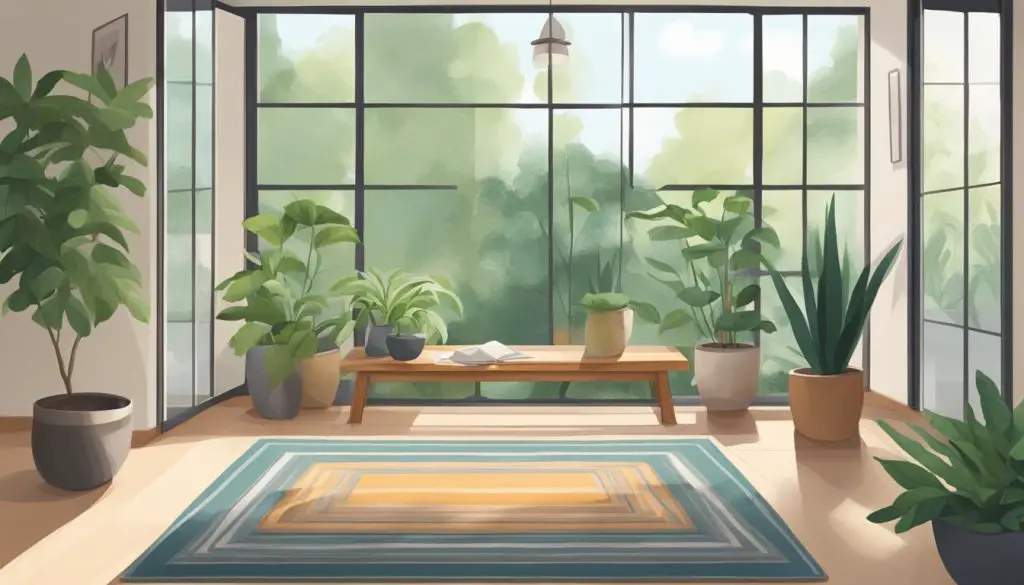
When I set out to create a budget-friendly meditation space, bringing elements of nature indoors was a priority. Here’s how I infuse nature into my tranquil sanctuary.
Indoor Plants and Greenery
I find that adding indoor plants to my meditation room invites a fresh and vibrant energy.
Opting for low-maintenance greenery such as spider plants, peace lilies, or even a bonsai tree can help foster a living connection to nature. These plants not only add visual appeal but also enrich the air quality, enhancing my meditation practice.
- Spider Plant: Thrives in indirect sunlight and purifies the air
- Peace Lily: Easy to care for and can improve indoor air quality
- Bonsai Tree: Represents harmony, peace, and balance
Inclusion of Natural Elements
To further the feel of nature, I incorporate natural elements like stones, crystals, or a small water feature, which add a tactile and auditory experience to the space.
Placing river rocks or a small fountain can magnify the calming effect, evoking the serenity of a babbling brook.
Natural Element Additions:
- Stones/pebbles: Use as decoration or for grounding exercises
- Crystals: Chosen for their specific properties, they enhance the room’s energy
- Water Feature: The sound of water can aid in deep relaxation
Opting for Wooden Elements and Bamboo
Wooden and bamboo accents craft a warm, organic touch to the room. I might use bamboo mats, wooden prayer beads, or furniture to create a cohesive look.
Bamboo, in particular, is sustainable and resilient, which makes it a great choice for someone environmentally conscious.
- Bamboo Mat: Durable and gives the room an earthy foundation
- Wooden Furniture: Select pieces that resonate with peace and simplicity
- Prayer Beads: Often made from wood, they’re a meaningful addition to my meditation practice
By taking these steps, I’ve noticed a significant improvement in the tranquillity of my meditation space. It feels like a retreat where I can connect with nature without stepping outside.
Step 3: Selecting Budget-Friendly Decor
When I’m looking to furnish my meditation space without overspending, I focus on choosing decor that’s not only affordable, but also imbues the room with tranquillity and a personal touch.
DIY Decor and Personal Touches
My meditation room is a canvas for expressing creativity while sticking to a budget. I’ve found that handmade items such as macrame wall hangings or painted stones add a unique and personal feel.
Upcycling common items can also work wonders; for instance, I create candle holders from repurposed jars and weave my own rugs or mats using old fabrics.
Here are some ideas:
- Macrame Wall Hanging: Use basic macrame knots to craft your design.
- Painted Stones: Select smooth stones and paint them with soothing colours or symbols.
- Upcycled Candle Holders: Place tea lights in cleaned jars for ambient lighting.
Affordable Artwork and Wall Art
I like to adorn the walls of my meditation space with art that inspires serenity without breaking the bank. I opt for inexpensive prints from local artists or create my own artwork.
Another great option is to hang poster-sized nature photographs that I find online for a nominal price and get printed at a local shop.
Sample Art Picks:
- Printable Zen Quotes: Frame these for daily inspiration.
- Nature Photographs: Large posters can act as windows to the natural world.
Using Budget-Friendly Meditation Cushions and Seating
A comfortable seating area is essential, but it doesn’t have to cost much. I’ve discovered that meditation cushions and mats can be found at reasonable prices if I shop around, especially online.
Sometimes, I use firm throw pillows or a stack of folded blankets as a makeshift meditation cushion. Here’s how I set up seating without spending a lot:
- Meditation Cushions: Look for discounts on specialist websites.
- Second-hand Shops: These can be great places to find unique chairs or poufs.
- DIY Seating: A pile of blankets or firm pillows can double up as a meditation seat.
Step 4: Designing for Comfort and Tranquillity
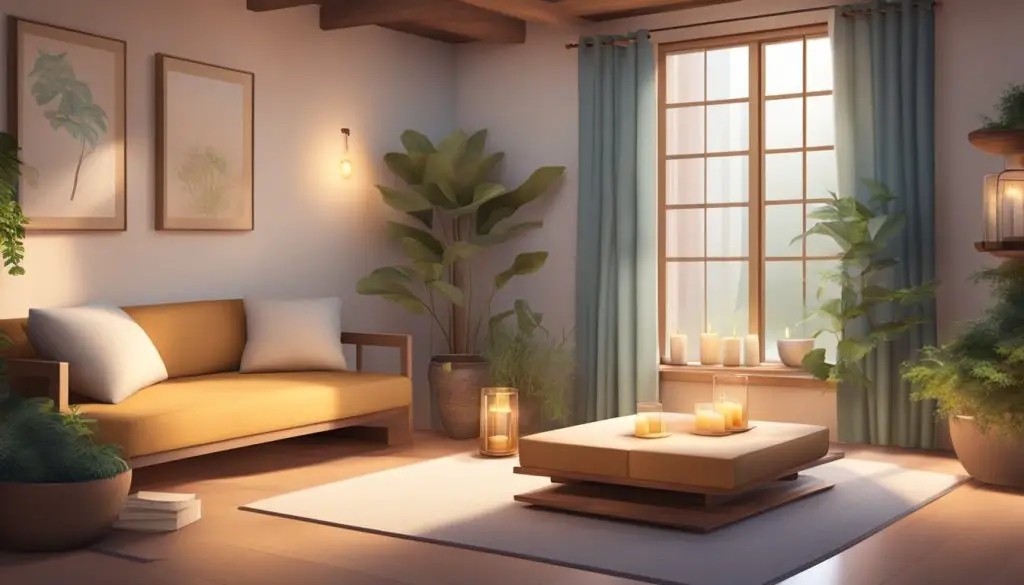
When I focus on comfort and tranquillity in my meditation space, I consider elements that appeal to my senses and contribute to an overall sense of calm.
Here, I’ll guide you through my choices for lighting, textiles, and additional comforts to enhance the serenity of your meditation room.
Soft Lighting and Candles
I find that the right lighting is essential for setting a tranquil mood.
During the day, natural light can be gently diffused with sheer curtains, creating a soft glow. As the sun sets, dimmer switches or soft, low-lumen lamps help maintain a peaceful ambiance.
The flicker of candles also adds warmth and comfort to my meditation room. Not only do they provide soothing light, but they can also introduce relaxing scents that can aid in meditation.
- Preferred candle types:
- Tea lights
- Pillar candles
- Scented candles (lavender, sandalwood)
Comforting Textiles and Rugs
My meditation room wouldn’t be complete without the tactile comfort of textiles.
A plush rug underfoot adds an instant layer of cosiness and can also serve to dampen sound, keeping the room silent and calm. I opt for natural materials like wool or cotton, as they add a beautiful and comfortable aspect to the room.
- Textile suggestions:
- Wool rugs
- Cotton throw rugs
- Bamboo mats
Adding Comfort with Pillows and Blankets
Cushions and pillows are the centres of comfort in my meditation space. They support a variety of seated postures and increase my physical ease.
I choose pillows filled with natural fibres for breathability and durability. To enhance the sense of cosiness and relaxation, I use blankets that are soft to the touch. A blanket can be draped over my shoulders or lap to create a snug, secure feeling during meditation.
- Comfy essentials:
- Buckwheat or cotton-filled meditation cushions
- Soft, easy-to-clean floor pillows
- Fleece or cotton blankets for warmth
Step 5: Creating a Focal Point for Meditation
In establishing a meditation space on a budget, I find it vital to create a central focal point that anchors my practice and imbues the space with intention and serenity.
Setting Up a Small Table or Shelf
I like to start by selecting a small table or shelf to serve as the foundation of my focal point. This isn’t just any piece of furniture—it’s a purposeful choice that represents the heart of my meditation area.
I choose a table that’s sizeable enough to hold a few key items but compact so it doesn’t overwhelm my limited space. A wooden table often adds a natural touch, but even a repurposed stool or a stack of books can do the trick if my budget is tight.
On my table or shelf, I carefully arrange:
- A selected fabric or scarf to add texture and colour
- A few candles or incense holders for calming scents and soft lighting
- Crystals that I feel drawn to for their reputed energetic properties, like amethyst for calm or clear quartz for clarity
Positioning Statues and Spiritual Elements
Next, I consider which statues or spiritual elements resonate with me to place on my meditation table; this could be anything from a Buddha statue to any symbol that aligns with my personal beliefs or contributes to a tranquil atmosphere.
It’s important that these items genuinely speak to me, as they help to focus my thoughts and bring a deeper sense of peace.
Arrangement tips for statues and spiritual elements:
- Items are chosen with intention—each piece should have a personal meaning or significance
- Placement is done with balance in mind, with possibly a larger item centred and smaller ones flanking it
- Space is left open for functional items like meditation beads or a journal
With these elements in place, I’ve found that my meditation space becomes a true sanctuary, personalised to my journey and designed to facilitate introspection and tranquillity.
Step 6: Maintaining Simplicity and Mindfulness
In creating my meditation space, I focus on simplicity and mindfulness, realising that less is often more. It’s about keeping the space open for reflection and free from distractions.
Adopting a Minimalist Approach
I adopt a minimalist approach because an uncluttered space promotes an uncluttered mind. Here’s how I achieve that:
- Furniture: I select one or two pieces of essential furniture, such as a comfortable cushion or a simple bench. Anything more, and the space starts to feel crowded.
- Decor: Instead of filling every corner, I choose one or two meaningful items, like a calming piece of art or a small indoor plant. These should encourage a sense of tranquillity without overwhelming the space.
Eliminating Distractions and Clutter
To truly embody mindfulness in my meditation room, I make conscious choices to eliminate clutter:
- Organisation: I use clever storage solutions to keep necessary items out of sight but within reach. A small shelf or a decorative basket can work wonders.
- Digital Detox: I remove electronic devices that can disrupt my focus and the tranquillity of the room. This helps me stay present and mindful during my meditation practice.
Step 7: Enhancing the Atmosphere with Scent and Sound
Creating an inviting atmosphere in my meditation space is essential for deep relaxation. I find that engaging my sense of smell and hearing with specific scents and sounds significantly improves my meditation experience. Here’s how I use aromatherapy and sound to enhance the ambience of my tranquil retreat.
Using Aromatherapy and Essential Oils
I often opt for essential oils in my meditation room to promote a sense of calm and mindfulness. Lavender oil is a go-to for its relaxing properties, and I sometimes use sage for its ability to cleanse the space.
- How I Use Essential Oils:
- I add a few drops of oil to my diffuser.
- For a subtler effect, I’ll place a bowl of water with a mix of essential oils on a radiator.
- Aromatherapy Stones:
- I place aromatherapy stones in my room; they’re porous and absorb the oils, slowly releasing the scent.
Incorporating Relaxing Music and Singing Bowls
The right soundtrack can transform my meditation practice, and I find that relaxing music helps to centre my thoughts. I also use singing bowls, whose resonant frequencies contribute to a meditative state.
- My Picks for Music:
- Nature sounds, like water flowing or birds chirping.
- Ambient instrumental music with slow, soothing rhythms.
- Utilising Singing Bowls:
- I gently strike the singing bowl to start and finish my meditation.
- Playing the bowl during meditation helps to maintain my focus.
Step 8: Considerations for Storage and Organisation
When setting up my meditation room on a budget, I find that clever storage and organisation are essential. They keep the space tidy and serene. Here’s how I approach it:
- Storage: I opt for minimalistic storage solutions that blend into the decor. I might use a small bookshelf or floating shelves as they don’t take up much space. This is where I neatly store any books, candles, or meditation guides. Multi-purpose furniture, like a bench with hidden storage, is another great way to reduce clutter.
- Organisation: For me, maintaining order is about simplicity. I designate a specific spot for each item and use decorative baskets or boxes. This helps me avoid leaving accessories scattered around, which might distract me during meditation.
- Accessories: I select a few meaningful items to aid in my meditation practice, like a singing bowl or a set of mala beads, and store them within reach. Keeping accessories to a minimum ensures the space remains open and peaceful.
- Area Rug: A comfortable area rug can define the space and add warmth. I choose one that’s easy to roll up and store away if I need more room. It’s another element I can tuck away to prevent the space from feeling cramped.
By integrating these storage and organisation elements seamlessly into my meditation room, I create a functional and calming space that allows me to focus on my practice without distraction.
Frequently Asked Questions
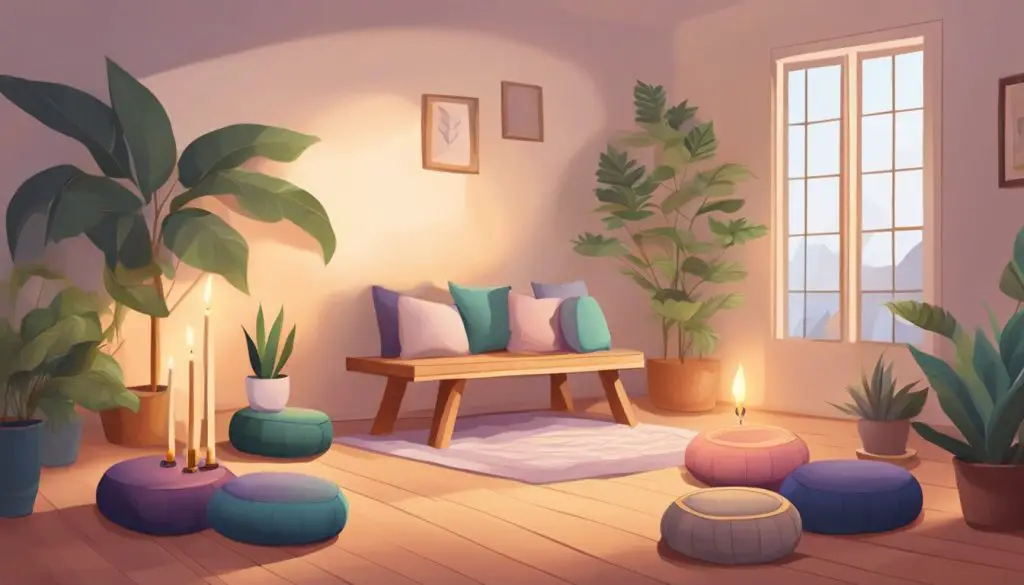
Setting up a meditation space doesn’t have to break the bank. I’ve found that with a bit of creativity and some do-it-yourself ingenuity, you can create a peaceful sanctuary for meditation on a budget.
How can I set up a cost-effective meditation space at home?
You can start by choosing a quiet corner and introduce elements like a comfortable cushion or a simple mat.
Using soft lighting or candles can add ambiance without costing much. The key is to use items you already have and to keep the space clutter-free.
What are some essential elements for a budget-friendly Zen room?
A budget-friendly Zen room should include items that promote relaxation such as comfortable seating, gentle lighting, and a few personal items that induce calm, like a favourite potted plant or calming artwork. Stick to a minimalistic approach, focusing on what truly aids your meditation.
Could you suggest some DIY decor ideas for a serene meditation area?
DIY decor for a serene meditation area could include handmade wall hangings, upcycled furniture for seating, and natural elements like stones or wood. You can also create a tranquil ambiance with homemade candles or a DIY water feature using a simple bowl and a pump.
What’s the best way to create a compact meditation spot without spending much?
For a small space, focus on essentials: a comfy floor cushion, perhaps a small shelf for a candle or incense, and a folded throw for warmth. Utilise vertical space for decorations like hanging plants or wall art, which don’t take up floor space.
How can I transform a small area of my room into a peaceful retreat?
Utilise the corner of a room by adding elements that signal tranquillity to you, such as soft colours and a designated mat or rug. Keep the area tidy and designate it only for meditation to build a mental association between the space and peacefulness.
Are there any creative tips for crafting a Zen den with limited resources?
Get creative with items you already own; drape soft fabrics for a makeshift canopy or paint calming scenes on canvas. Use books to elevate a candle or incense holder and gather pebbles or shells in a bowl to create natural focal points. Your creativity is the best resource in crafting a Zen den.

